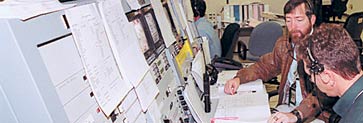By Oscar Toledo
Background
At times we become so involved in a project that we forget about the customer. What the customer requires, needs, and expects of us should always be the driving force behind our efforts.

“The Immersion” by Charles Schmidt depicts astronaut training in the Neutral Buoyancy Simulator at Marshall Space Flight Center. An astronaut is practicing EVA activities on a mockup of the Hubble Space Telescope.
Such thinking leads to the logical conclusion that recruiting the customer’s active involvement is a critical component of project management.
Without question the customer should be part of the development team. One way to integrate the customer into the development team (civil servants and/or contractors) is to set up a partnership. This will be different from the traditional customer-supplier relationship. This type of arrangement is not always possible depending on contractual and/or disclosure obligations of the project. When the project manager is at liberty to do so, he or she should seriously engage the customer. In my experience, I have always found that even in extremely technical and politically challenging projects, the customer has been the key to the successful implementation of the project.
Procedures
- The customer and supplier should agree on a partnership for the purpose of developing the product or providing a service. The partnership should require the customer to provide personnel with appropriate backgrounds to actively participate as members of the project management team, the subsystem development teams, and the integration and validation team (the teams could vary based on project needs). The supplier must create an environment in which the development team accepts the customer and there is open communication between all parties.
- From the start, establish that the customer is a member of the development team.
- The customer/supplier team (CST) is responsible for the Formulation Phase in the definition of requirements, budgets, timelines, performance, and expectations.
- The CST is involved in the architecture development/evaluations, trade studies of cost, performance, and schedules.
- The CST is involved in the generation of the baseline project plan containing performance, cost, schedules, and risk assessments.
- The customer and the project manager are together involved in the approval phase of the project. This is a relationship of collaboration, not a customer-to-supplier relationship.
- The CSTs have joint responsibility for the Implementation Phase of the project.
- The customer works side by side with the supplier and is held accountable with the rest of the team for meeting milestones.
- The customer is actively involved in risk, performance, schedule, and cost trade-offs made during implementation and for keeping open communications with management.
- The customer also has a critical role in the Evaluation Phases throughout the development cycle.
- The customer is one of the key players in the evaluation process, providing valuable insight, acceptance, and sharing in the responsibility for project status and any redirections.
Search by lesson to find more on:
- Partnerships
- Communication
About the Author
 |
Oscar Toledo is the Associate Director for Technology at the Kennedy Space Center and has received the NASA Exceptional Service Medal. |








